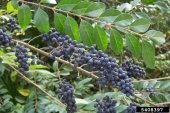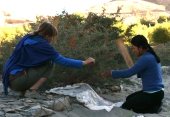

 1
1




Works at a residential alternative high school in the Himalayas SECMOL.org . "Back home" is Cape Cod, E Coast USA.
 1
1




 1
1




find religion! church
kiva! hyvä! iloinen! pikkumaatila
get stung! beehives
be hospitable! host-a-hive
be antisocial! facespace




live simply. live well. http://www.handcraftedtravellers.com/









Cheryl and Roland Magyar wrote:Even for firewood it is a poor choice in our experience. It *pops* with low heat and isn't very pleasant to split.
find religion! church
kiva! hyvä! iloinen! pikkumaatila
get stung! beehives
be hospitable! host-a-hive
be antisocial! facespace





 1
1




Logan Simmering wrote:Not the wood, but apparently you can make a useful flour from the fruit.
Works at a residential alternative high school in the Himalayas SECMOL.org . "Back home" is Cape Cod, E Coast USA.









 1
1




Works at a residential alternative high school in the Himalayas SECMOL.org . "Back home" is Cape Cod, E Coast USA.








"We have it in our power to begin the world over again." - Thomas Paine




 1
1













Works at a residential alternative high school in the Himalayas SECMOL.org . "Back home" is Cape Cod, E Coast USA.
 1
1




Country oriented nerd with primary interests in alternate energy in particular solar. Dabble in gardening, trees, cob, soil building and a host of others.









Works at a residential alternative high school in the Himalayas SECMOL.org . "Back home" is Cape Cod, E Coast USA.
 1
1








Brenda
Bloom where you are planted.
http://restfultrailsfoodforestgarden.blogspot.com/













Works at a residential alternative high school in the Himalayas SECMOL.org . "Back home" is Cape Cod, E Coast USA.








 1
1




yet another victim of Obsessive Weeding Disorder




For firewood it burns good and hot, moderate amount of ash and isn't bad about creosote. The bark is extremely hard on chain saw chains making cutting a bit of a pain. Best guess is that it collects a lot of dirt in its layers. Splits decently if good wood and dry. Miserable stuff to harvest for firewood because nothing is even mildly straight and because of all the thorns. Best answer to help with harvest that I am aware of is goats followed by some cribbing horses. Goats wipe out the under story and the horses get rid of the rest up to more than head high. Normally the branch thicket around the base of the tree means cutting to even clear a place to work to fell the tree. Giant Mechanical shears or cutting blades help here so humans don't have to get close to cut them down. The thorns are rough to work around.
For construction wood the answer is unlikely. The trees tend to spiral crack with changing moisture levels and getting straight pieces even 4 to 6 feet long for wood working is difficult. The other problem is that if the trunk is over about 8 inches in diameter the odds are the heart wood will be rotten. Lots of years spent looking for cabinet size pieces taught me that. For every about 15 or 20 trees cut down with large trunk size I find one tree with good heart wood in the big part of the trunk. Now it might make artificial timber. The process that uses scrub wood and crushes it and adds glue to make an engineered wood might work with these.(I have wondered about this one for 25 years since I saw the original article on it.) It is a beautiful wood working wood especially quarter sawed. Really bad for fine detail work because places in the grain tend to be really fragile. For good durability avoid sharp square profiles along with fragile profiles and round all edges over.
 1
1




yet another victim of Obsessive Weeding Disorder





 1
1




Works at a residential alternative high school in the Himalayas SECMOL.org . "Back home" is Cape Cod, E Coast USA.




yet another victim of Obsessive Weeding Disorder
 1
1




 1
1




 1
1




A human being should be able to change a diaper, plan an invasion, butcher a hog, conn a ship, design a building, write a sonnet, balance accounts, build a wall, set a bone, comfort the dying, take orders, give orders, cooperate, act alone, solve equations, analyze a new problem, pitch manure, program a computer, cook a tasty meal, fight efficiently, die gallantly. Specialization is for insects.
-Robert A. Heinlein
 3
3




Earthworks are the skeleton; the plants and animals flesh out the design.

 1
1




Some places need to be wild








Jackie
~ Be the change!














Some places need to be wild




Jackie Frobese wrote:As for the fruit... I have a small obsession with wild edibles. When autumn olive was first introduced to me I was so excited, until I tried them. The astringency was rough. I did find that cooking them seemed to do away with that, making them much more palatable. I made a jelly from them that had a tart flavor like cranberries. It was enjoyable. I have also continued to try at least one small handful every year. I suppose I’m a diehard optimist. Amazingly the flavor has grown on me. I seem to enjoy them a bit more each year.
Permaculture...picking the lock back to Eden since 1978.
Pics of my Forest Garden

|
expectation is the root of all heartache - shakespeare. tiny ad:
Support permies and give beautiful gifts to gardeners: permaculture playing cards.
https://gardener-gift.com/
|






